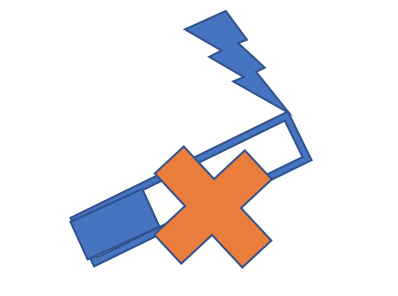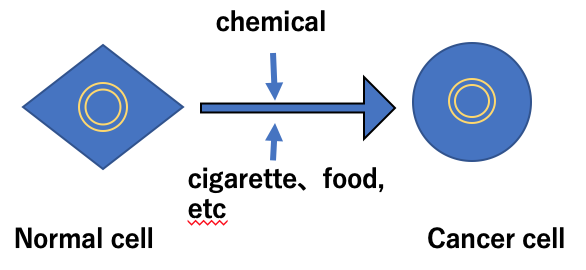
Cancer is a genetic disease
Cancer is ranked as the leading cause of death in Japan, accounting for more than one in three deaths. Lung, stomach or colorectal cancers are the most common. Cancer is caused by genetic mutations leading to unrestricted proliferation of cancers cells, causing fatal physical and physiological defects throughout our body. It usually takes more than 10 years for sickness to become apparent from the first genetic defect. Currently, as average life spans grow longer, the number of deaths from cancer is also increasing. When corrected for the increase in lifespan, the growth in the number of cancer related deaths is not actually that large. However, cancer is still ranked as the number one cause of death. Therefore, many physicians and cancer researchers are striving to cure this disease. An overview of the history of cancer research may shed light on the causes of this threat to our health.

First of all, why do we suffer from cancer? According to findings in epidemiologic research, cigarettes and some foods are the main causes of the disease. These results suggest that some specific materials in cigarette smoke and foods might have a causal relationship with cancer. Meanwhile, certain types of jobs have also been observed to increase the risk of cancer. More than a century ago high rates of testicular cancer was frequently observed among chimney sweepers in London. The cause was suspected to be soot (tar) that was not sufficiently removed during cleansing. Based on this finding, the Japanese pathologist Dr Katsusaburo Yamagiwa applied coal tar, which is thought to have the same composition as smoke, to rabbit ears and succeeded in artificially creating skin cancer for the first time in the world. Subsequently, research into the relationship between the chemicals contained in tar and cancer was conducted, mainly in Japan. As a result, several organic compounds like benzpyren were found to cause cancer. Several carcinogenic materials were also found in foods. The next question to be answered was how such compounds were able to produce cancer cells?


It was suspected that oncogenic compounds would bind to DNA and induce mutations that lead to cancer. However, it was not determined which gene in our cells could be targeted by these chemicals leading to the development of cancer cells. In 1911, a new finding led to an unexpected breakthrough. Dr P. Rous at the Rockefeller Institute in America pulverized a cancerous tumor in the muscle of a chicken, then filtered it through a piece of ceramic. He found that when the filtrate was injected into a healthy chicken, sarcomas were produced again revealing the existence of an oncogenic virus now named Rous sarcoma virus (RSV). Dr. Rous was awarded the Nobel Prize in Physiology or Medicine 50 years after this original finding. Then a sarcoma causing gene was found in the RNA of RSV (named RAS oncogene). Later, researchers studied the mechanism by which the RAS gene caused cancer. The following is a summary of the final results.
Cancer causing genes named viral oncogenes were found in several other oncogenic viruses independent of each other including the Fujinami oncogenic virus discovered by Prof. Fujinami at Kyoto University. Surprisingly, genes with nucleotide sequences similar to human DNA were found, now known as cellular proto-oncogenes. Proto-oncogenes were thought to be integrated into viral genomes from human genomes during repeated infection of human cells. Proteins of the cellular proto-oncogenes are thought to be involved in the mechanisms for cell division.
Cell multiplication is initiated by signals from outside cells like hormones and growth factors. For example, when skin is injured, damaged skin cells excrete growth factors that fill the damaged area and enhance cell multiplication surrounding the injury. These factors bind to cells and transfer signals from surface to nucleus that stimulates the duplication of DNA and synthesis of proteins required for cell division. This signal transmission to the nucleus is supported by several independent proteins called signal transducers. When a signal for cell multiplication from outside the cell binds to the cell surface, signals from the signal transducers switch on genes to start new synthesis of proteins required for cell-growth, leading to DNA duplication and cell division. Viral oncogenes have a genetic mutation which causes malfunctions in the regulation of gene expression. For example, even without growth signals from outside the cells, proteins (oncogenic gene products) continue to transfer signals for continued duplication and cell division. This oncogenic mutation was believed to be caused by cigarette-smoke and several oncogenic materials in our foods.


Once these important facts were revealed, it was thought that the process of cancer formation known as oncogenesis was clearly understood. However, the oncogenic mechanism was later found to be more complex than originally thought. When cancer cells are fused with normal healthy cells into a single fused cell, cancer cell characteristics were not expressed. This seemed to contradict observations of the virus onco-genes. Interestingly, in the case of cancer found in human retina, a gene called Rb1 was found to be involved in oncogenesis. Only when genetically recessive Rb1 from both mother and father was received would cancer form in the retina. This finding suggested that retinal cancer was only caused when all proteins of the Rb1 gene in a retinal cell lost function (i.e. genetically recessive). Further, it was found that proteins produced by the normal Rb1 gene suppress oncogenesis. This finding explains why oncogenesis is suppressed when a normal cell is fused with a cancer cell as the oncogenic gene is suppressed by the normal gene. This type of gene is called a tumor suppressor gene. When mutations occur in this type of gene causing loss of cancer suppression, the cell becomes cancerous. For human cancer, this functional defect in tumor suppressors is now believed to be involved in most cases.
This is a brief overview of scientific achievement in finding the basic mechanism of cancer generation. Various methods are now known to identify carcinogenic materials in daily foods. As a result, risks from food may be decreasing. As mentioned above, cancer takes more than 10 years to become visible after a genetic defect caused in the cellular proto-oncogenes and suppressor oncogenes. During this period, our immune system protects our body from cancer by removing cancer cells as alien bodies. Because of this, maintaining a strong immune response is important for a healthy life.
